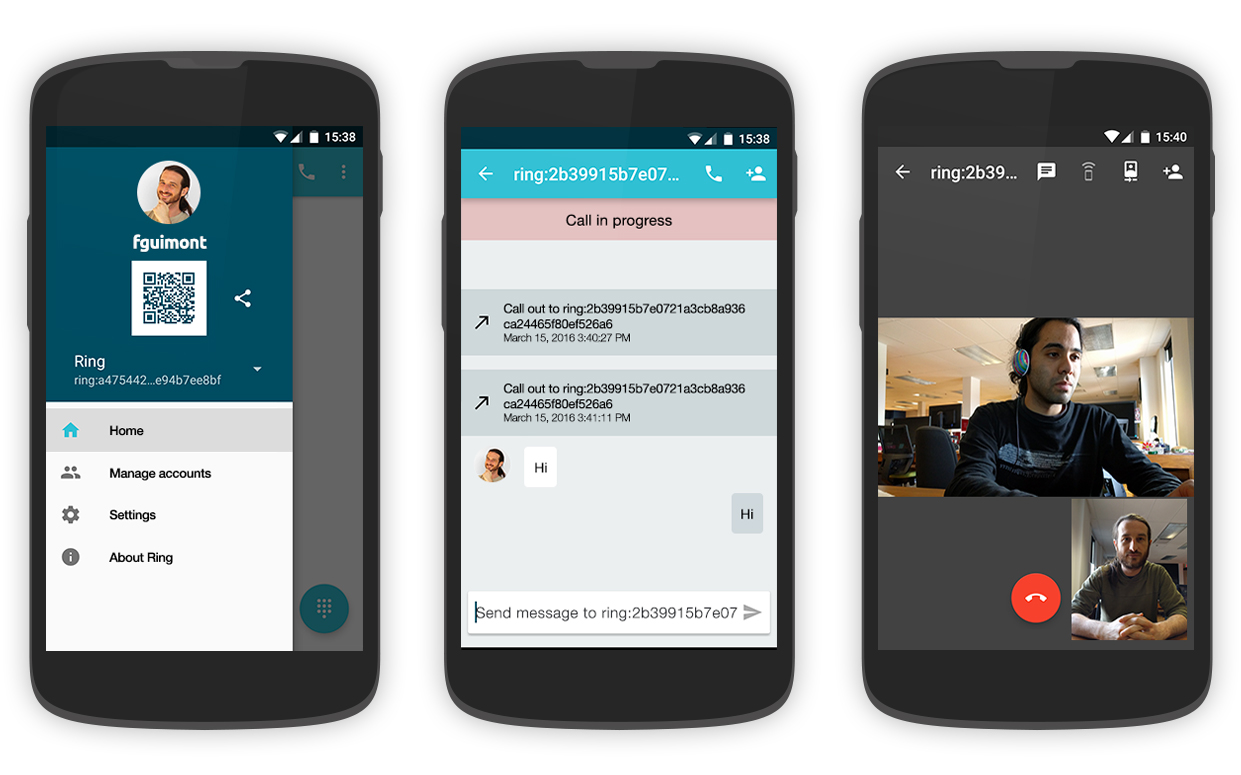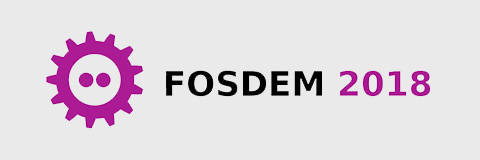Over the last few months, Ring – under the GPLv3 licence – has created an effervescence in the free-source software, hacker and cybersecurity world, although it is only in its beta version.
Many Internet and industrial operators of telecommunications, and the sustainable development industry are showing close interest. Presented in the plenary at FOSDEM 2016 in Brussels a few weeks go, Ring will be a major topic this weekend simultaneously at the FOSSASIA conference in Singapore and especially during the LibrePlanet Conference in Boston organized by the famous Free Software Foundation that will celebrate its 30th anniversary.
 On this occasion, Cyrille Béraud, the President of Savoir-faire Linux, will present in greater detail Ring, to better understand what free-software is and why, as many specialists are murmuring, this software can be a milestone in Internet’s history.
On this occasion, Cyrille Béraud, the President of Savoir-faire Linux, will present in greater detail Ring, to better understand what free-software is and why, as many specialists are murmuring, this software can be a milestone in Internet’s history.
Can you explain to us what Ring is exactly?
Firstly, I would like to let you know that Ring is an open-source software, therefore it is a common good. From a functional perspective, the public will discover it as some sort of Skype or Hangout.
Ring allows to establish an encrypted video, audio, very high quality text communication between two or many people, no matter where they are in the world. It is available on Linux, Windows, Mac/OSX, and Android platforms and within the next few months on iOS. It is distributed with its sources under the GPLv3 licence.

However, I would like to bring particular attention to the fact that Ring is still a young software that remains fragile and that in numerous situations will not function perfectly, even at times not at all. This being said, it is improving every day and in an standard environment and for domestic use, it functions very well.
But what distinguishes Ring from other softwares that have the same functionality?
Ring allows to establish a peer-to-peer communication without passing through a central server. That is the determining point. Ring is firstly a distributed communication platform. No need for operators, to manager servers, no more costs associated to each of your calls all the while Ring offers more freedom and security. In a professional context, many companies can benefit from its flexibility and important economies. For everyone, it is the possibility to communicate freely at no cost no matter where, in securely manner.
Technically, we have based ourselves on already well proven technologies : ffmpg/libav, GnuTLS, pjsip, etc. However, regarding the innovation at the core of Ring, we have used the concept of DHTs, Distributed Hash Tables. We have developed our own library, OpenDHT, only available on Github, by introducing important innovations, when joined with ICE and SIP protocols, allow to cross the routers, firewalls, to localize, in a certain manner, a user or an equipment, even if it is found in a private network, and establish, if one possesses its contact’s user identification, a highly secure communication channel in real time, anywhere in the world.
 Because of this feature and the fact that Ring uses open and recognized standards, this platform allows to sketch a truly universal non hierarchical system of communication on the Internet, while allowing not only one communication between two people, however more generally, between two or a multitude of objects on the Internet. From this point of view, the innovations that we have made available through Ring, open numerous possibilities and industrial applications to the public. We already have in our laboratory, many prototypes based on very light embedded platforms, that from Ring, can interconnect with home automation or data acquisition systems. It is quite spectacular and very promising.
Because of this feature and the fact that Ring uses open and recognized standards, this platform allows to sketch a truly universal non hierarchical system of communication on the Internet, while allowing not only one communication between two people, however more generally, between two or a multitude of objects on the Internet. From this point of view, the innovations that we have made available through Ring, open numerous possibilities and industrial applications to the public. We already have in our laboratory, many prototypes based on very light embedded platforms, that from Ring, can interconnect with home automation or data acquisition systems. It is quite spectacular and very promising.
To complete this overview, it is important to note that Ring functions in degraded mode and even while being completely disconnected from the Internet. Imagine an isolated village in Africa or in India with a poor connexion. In case of a disconnection to the Internet, Ring’s distributed system, will retract itself on its nodes that it can reach and can continue to work. In the example where the village is disconnected from the world, the residents can continue communicating amongst themselves. From this point of view, Ring can participate in sustainable development and contribute to the economy and democracy of a country that does not have a developed communication infrastructure.
You see, Ring has a lot of potential! And to make Ring and its underlying technologies available to a greater number of people, to allow each and everyone through the world to invent their own usage of Ring, it had to be a free software.
Is there an economic model behind Ring and can you briefly introduce Savoir-faire Linux?
Of course there is an economic model behind Ring! It is the one of free-software. We create use values that we make available freely to everyone. These use values create an economy of services. This economy, open and competitive, creates a lot of value of course. In the case of Ring, Savoir-faire Linux will have its place. This economy is based on exchange and collaboration. This is the business model of Savoir-faire Linux. It opposes itself to the economy of windfall and the appropriation of wealth by a small number.
To conclude, Savoir-faire Linux is a Canadian service company based in Montreal, with teams in Quebec and Toronto, even in France, in Paris. We also have a presence in the Ivory Coast through a partnership.
With our 110 engineers, all of very high level and all specialized in open technologies, we are present in the defence and embedded electronics sector, in the banking sector, with Desjardins our client, as well as in the insurance sector, the software engineering sector with the Canadian Space Agency, the management information sector with the Organisation Internationale de la Francophonie and supply numerous local enterprises.
We also have, and it is essential for us, to create strong ties with the worldwide actors of free sofware. I am thinking specifically about the Linux Foundation, from who we distribute our trainings and to our Open Source partner editors, such as RedHat or Liferay. We also have many contributions in free projects, such as the Linux core. Behold, in summary, what is Savoir-faire Linux.
Savoir-faire Linux is the ambition to create wealth through values. We don’t always succeed. But every day, over the past 15 years, we continue to add value our work with two passions that reside in us : liberty and excellence.



 On this occasion,
On this occasion, 
 Because of this feature and the fact that Ring uses open and recognized standards, this platform allows to sketch a truly universal non hierarchical system of communication on the Internet, while allowing not only one communication between two people, however more generally, between two or a multitude of objects on the Internet. From this point of view, the innovations that we have made available through Ring, open numerous possibilities and industrial applications to the public. We already have in our laboratory, many prototypes based on very light embedded platforms, that from Ring, can interconnect with home automation or data acquisition systems. It is quite spectacular and very promising.
Because of this feature and the fact that Ring uses open and recognized standards, this platform allows to sketch a truly universal non hierarchical system of communication on the Internet, while allowing not only one communication between two people, however more generally, between two or a multitude of objects on the Internet. From this point of view, the innovations that we have made available through Ring, open numerous possibilities and industrial applications to the public. We already have in our laboratory, many prototypes based on very light embedded platforms, that from Ring, can interconnect with home automation or data acquisition systems. It is quite spectacular and very promising.




Interesting project, but why so many different GUIs?
Hello Leviant! Are you referring to the screenshots on the Ring website? Thank you!
ring is great work, but why don’t you make an IOS APP for the iphone?